| Columns Retired Columns & Blogs |
Another nominee for Stereophile 2020 product of the year award, NAD M10 :-) ........
I measured the Masters Series M10 using my Audio Precision SYS2722 system (see the January 2008 "As We See It"). As the NAD is a class-D design, I didn't run my usual preconditioning test of using the amplifier to drive a 1kHz tone at one-third power into 8 ohms. Nevertheless, before doing any testing I ran it for an hour at a moderate power level, to ensure that it was fully warmed up. Because class-D amplifiers emit relatively high levels of ultrasonic noise that would drive my analyzer's input into slew-rate limiting, all measurements were taken with Audio Precision's auxiliary AUX-0025 passive low-pass filter, which eliminates noise above 200kHz. Without the filter, there was 250mV of ultrasonic noise present at the loudspeaker terminals, which is typical for an nCore output stage.
The M10 runs warm. After an afternoon of testing, the top panel's temperature was 95.6°F/35.4°C. The System Info menu on the front-panel display indicated that the internal temperatures were "Left 60°C, Right 62°C."
Looking first at the analog inputs: With the NAD's volume control set to its maximum, the voltage gain at 1kHz into 8 ohms measured a relatively low 29.6dB from the speaker terminals and 4dB from the preamplifier outputs. The line inputs preserved absolute polarity (ie, were noninverting), and the input impedance was 16k ohms at low and middle frequencies, dropping to 4.5k ohms at 20kHz.
The preamplifier output impedance was a usefully low 92 ohms in the midrange above but increased to 135 ohms at the bottom of the audioband, probably due to the presence of an output coupling capacitor. The M10's output impedance at the speaker terminals was very low, at <0.01 ohms from 20Hz to 20kHz, the measured value including the series resistance of 6' of speaker cable. Consequently, the variation in frequency response with our standard simulated loudspeaker (fig.1, gray trace) is minimal. The traces in fig.1 cut off sharply above 20kHz, due to the M10 converting its analog inputs to digital with what appears to be a sample rate of 44.1kHz. Unlike NAD's more expensive M32, which allows the analog inputs to be digitized at 48, 96, or 192kHz, the M10's analog/ digital converter runs at just the one rate. The M10's reproduction of an analog 1kHz squarewave has the ringing on its leading and trailing edges that are typical of a linear phase reconstruction filter (fig.2) and a 10kHz squarewave is reproduced as a sinewave (fig.3), due to all the odd-order harmonics that would give the wave its square shape being removed by the A/D converter's antialiasing filter.
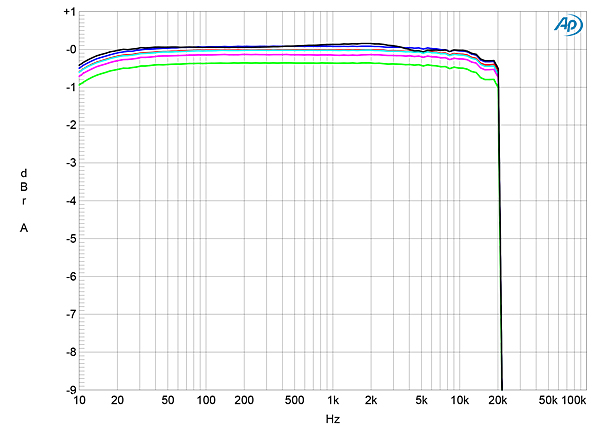
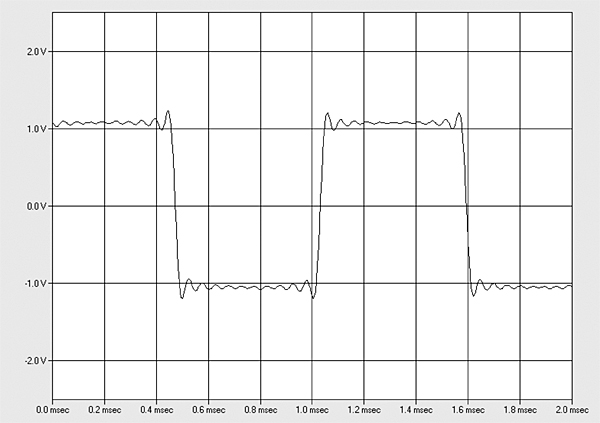

The M10's treble and bass controls offer a maximum boost of 6dB. As you can't have levels higher than 0dBFS in a digital system, switching on the tone controls with them set to do nothing reduces the signal level by the same 6dB. Fig.4 shows the effect of the NAD's bass and treble controls set to their +6dB and –6dB positions. The bass control offers a range of ±6dB below 70Hz, the treble control +5.5/–6.7dB at 20kHz. I created this graph using S/PDIF data sampled at 192kHz to show what happens above the audioband. It implies that the M10's DSP operates at 96kHz even when fed 192kHz data.
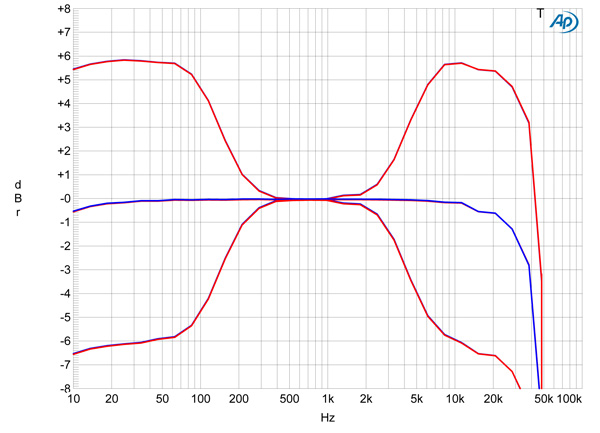
Channel separation was good rather than great, at >70dB in both directions below 1kHz but decreasing to 45dB at 20kHz. With the Audio Precision ultrasonic filter, the analog inputs shorted to ground, and the volume control set to the maximum, the wideband, unweighted signal/noise ratio (ref. 2.83V into 8 ohms) measured 55.8dB in the left channel and 60.3dB in the right. Restricting the measurement bandwidth to 22kHz increased the ratio to a respectable 75dB in both channels, and an A-weighting filter increased it further, to 78.2dB. Spectral analysis of the NAD's low-frequency noise floor (fig.5) revealed there to be a spurious tone present at 60Hz, this related to the AC power-line frequency but probably inaudible at –68dB ref. 2.83V into 8 ohms.
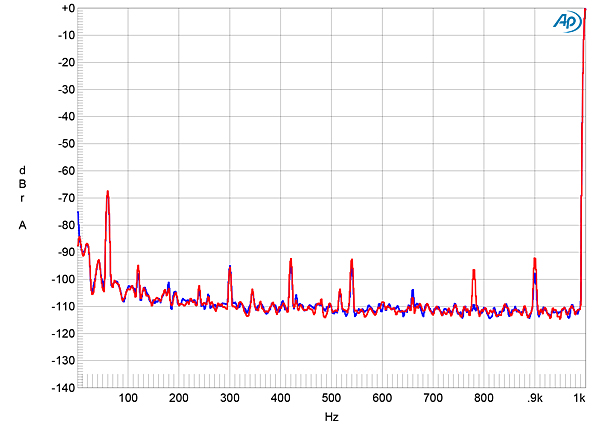
The M10 is specified as delivering a maximum continuous output power of 100Wpc into 8 ohms (20dBW). At our usual definition of clipping (ie, when the percentage of THD+noise in the amplifier's output reaches 1%), with continuous drive the M10 exceeded its specified power. It clipped at 155Wpc into 8 ohms (fig.6, 21.9dBW) and at 295Wpc into 4 ohms (fig.7, 21.7dBW). Distortion levels at moderate powers (fig.8) were low and dominated by noise, more so in the left channel (blue, cyan, and gray traces) than the right (red and magenta). Although the shape of the THD+N spuriae waveform at 30Wpc into 8 ohms (fig.9, bottom trace) is obscured by high-frequency noise, the distortion signature appears to be primarily third-harmonic in nature. This was confirmed by spectral analysis (fig.10), with the second harmonic 6dB lower in level and higher- order harmonics all lying below –100dB (0.001%). Intermodulation distortion was very low (fig.11), but as with the M32 the noise floor begins to rise above 15kHz.
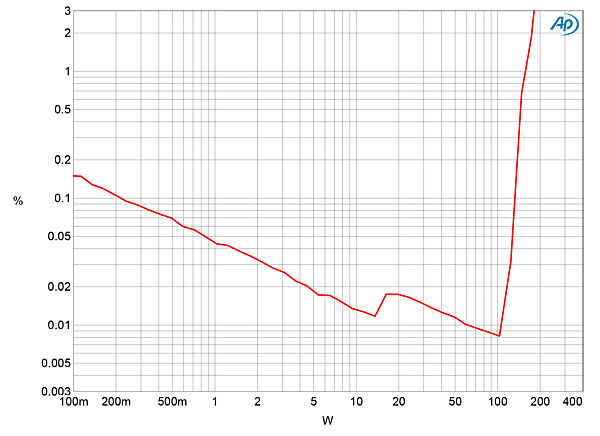
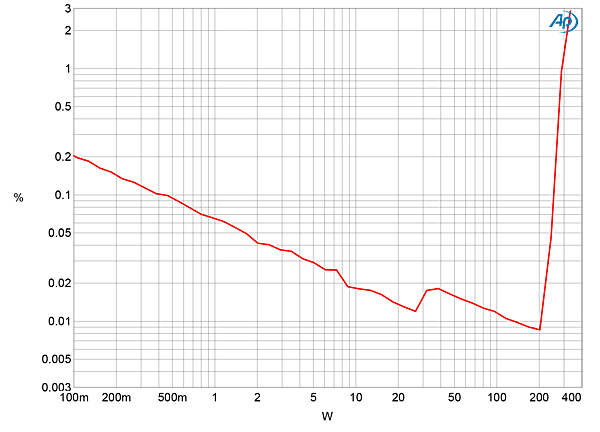
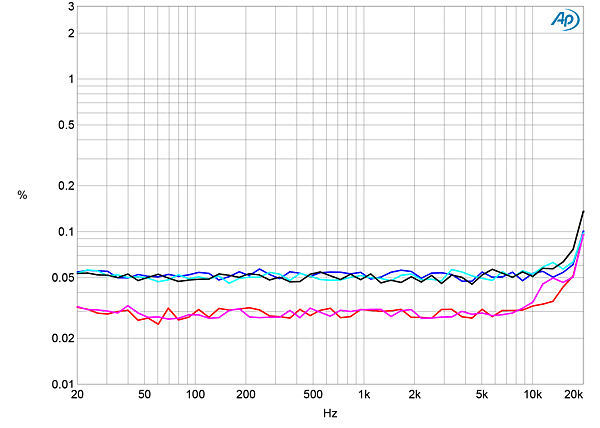
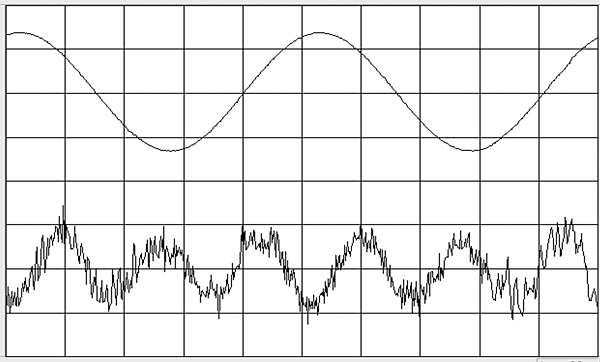
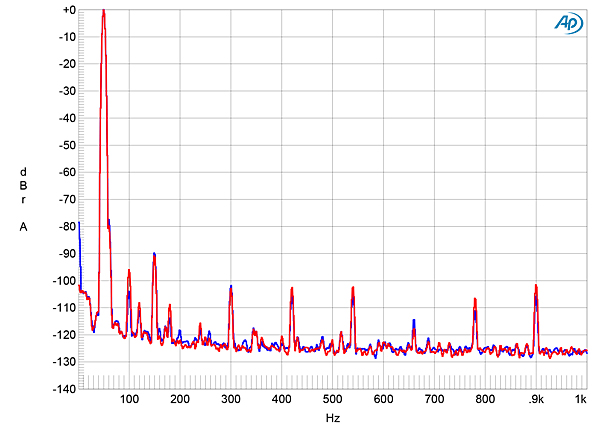
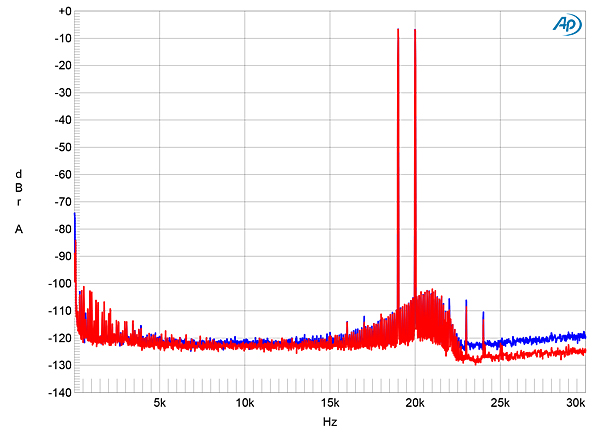
To examine the M10's performance with digital input data, I used the Audio Precision's optical and coaxial S/PDIF outputs and data sent to the M10 via Wi-Fi from my Roon Nucleus+ server. There were no significant differences between the data sources. The coaxial input locked to datastreams with all sample rates up to 192kHz. The optical TosLink input, however, was restricted to 96kHz and below. The BluOS Wi-Fi connection worked with data sampled at up to 192kHz.
With digital input signals the M10's front-panel meters are calibrated in dBFS—ie, 1kHz at –12dBFS is indicated as "–12dB." A 1kHz digital signal at –12dBFS resulted in an output level of 15.8V into 8 ohms with the volume control set to the maximum, which suggests that the M10's gain architecture is well-organized. The NAD's impulse response with 44.1kHz data (fig.12) indicates that the reconstruction filter is a conventional linear-phase type, with time-symmetrical ringing to either side of the single sample at 0dBFS. With 44.1kHz-sampled white noise (fig.13, red and magenta traces), the M10's response rolled off sharply above 20kHz, reaching full stop-band suppression just above half the sample rate (vertical green line). An aliased image at 25kHz of a full-scale tone at 19.1kHz (blue and cyan traces) can't therefore be seen, though the noise floor starts to rise at ultrasonic frequencies. The distortion harmonics of the 19.1kHz tone are visible above the ultrasonic noise floor, the third harmonic being the highest in level at –60dB (0.1%).
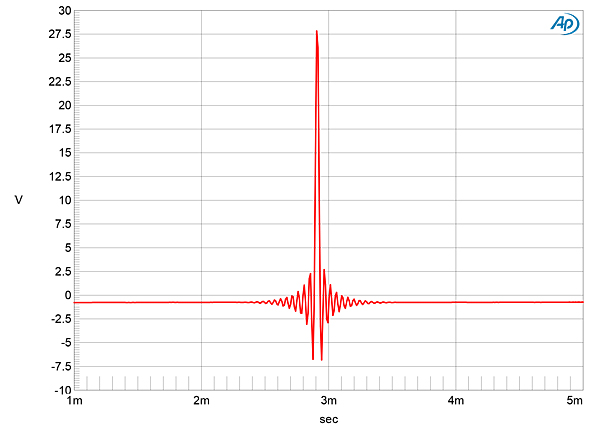
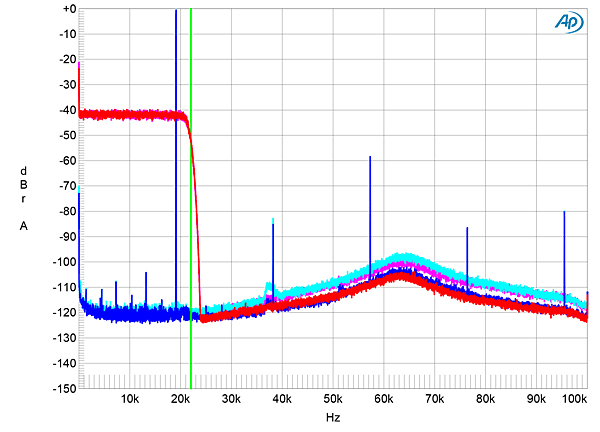
When I examined the NAD's digital frequency response with coaxial S/ PDIF data at 44.1, 96, and 192kHz (fig.14), the response at the two lower rates dropped off sharply just below half the sample rate. The response with 192kHz data (blue and red traces) extended higher than with 96kHz data (cyan, magenta) but not by much. When I increased the bit depth from 16 to 24 with a dithered 1kHz tone at –90dBFS (fig.15), the noise floor dropped by almost 12dB, meaning that the M10 offers 18 bits' worth of resolution, 2 bits less than the M32. With undithered data representing a tone at exactly –90.31dBFS (fig.16), the three DC voltage levels described by the data were well resolved and the waveform was perfectly symmetrical. With undithered 24-bit data, the result was a clean sinewave (fig.17).
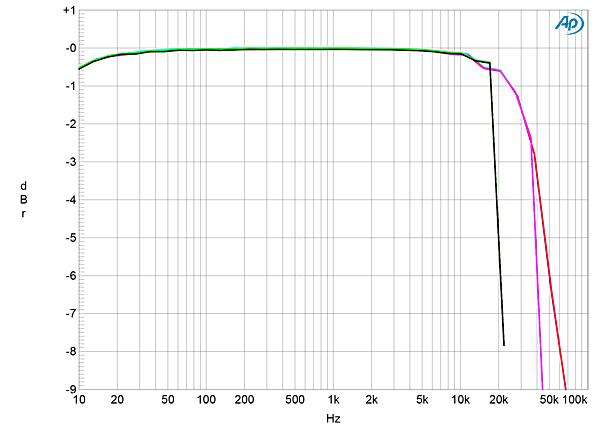
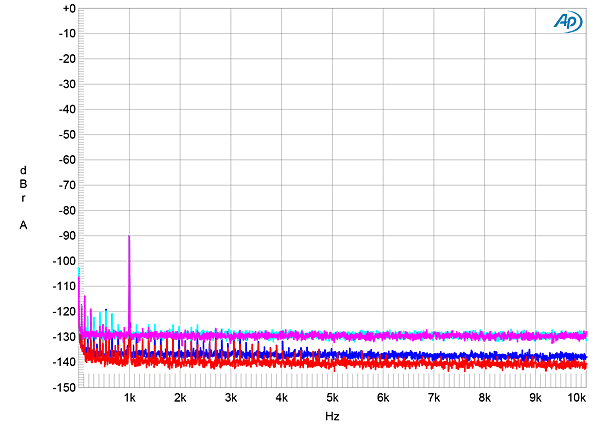
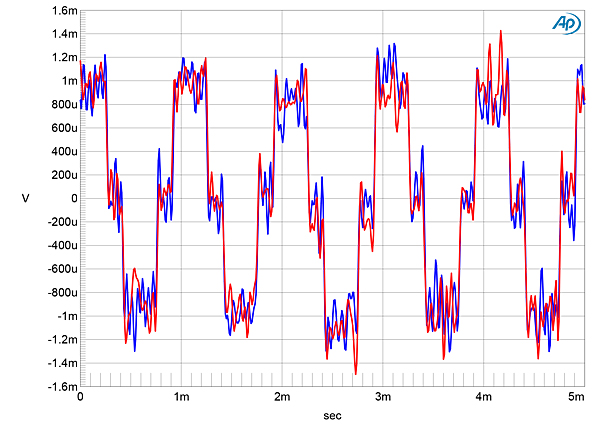
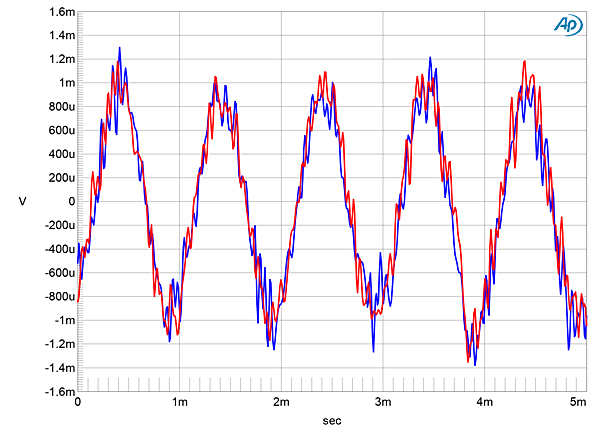
The NAD's rejection of word-clock jitter with 16-bit Wi-Fi data (fig.18) was superb, with all the odd-order harmonics of the LSB-level, low-frequency squarewave at the correct levels, indicated by the sloping green line in this graph. However, the left channel (blue trace) was a little noisier than the right (red).
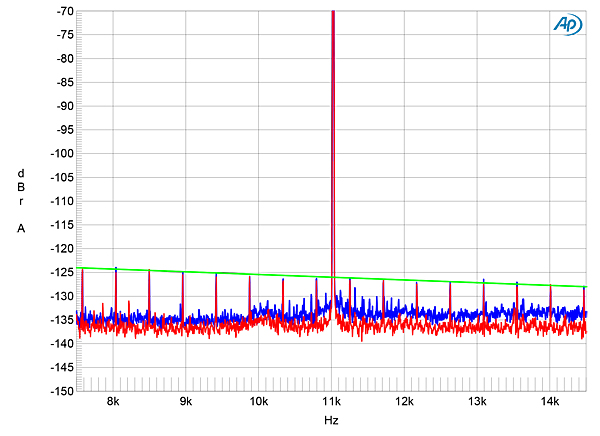
Like its big brother, NAD's M10 packs a lot of well-engineered performance into its relatively small chassis.—John Atkinson

Another nominee for Stereophile 2020 product of the year award, NAD M10 :-) ........

'Thin Red Line' and 'Bold Red Line' :-) .........

The Transistor was the most important invention of our last Century, wasn't it?
This high-achieving little box seems like a dam nice 1980 Era Hifi extrapolated out into our new 21st Century needs. ( I haven't yet had the chance to ask my Michigan NAD Critic if this box is serviceable or if it's another unserviceable throwaway, as so many electronics from Asia seem to be nowadays ).
As I started reading this review I'd thought that the device was the size of a BIG Mono Amplifier. Of course, it isn't at all "Large" unless it's compared to an iPhone or a Dragonfly .
Its amazing that a little device like this could be sooooooo dam powerful. Phew, seems like a parade motorscooter the Shriners ride but with 3,000 horsepowers.
Yet as powerfully potent as this NAD is, only a few pages away is a descriptive comparison of two low power amps serenading our HR into blissful oblivion.
Ultra high performing 21st Century Transistors vs. low power Valves ? Can I have both?, pleeeeeezzzzeeee
Tony in Venice ( all over Primary country & Counties )
ps. as much as I've abandoned ( and discourage ) vinyl hoarding, Mr. Dudley's writings are delightful ( especially the Naim Quad descriptions )
ps. thank you for the delightful read whilst out on the lonely trail.

... eat it too? Absolutely.
Just connect the pre-amp outputs of the NAD M10 to the inputs of a Luxman MQ-300 8W triode tube power amp.
http://www.luxman.com/product/detail.php?id=17

Are you spending any time in 'wine caves' and drinking from '$900 a bottle wines', Mr.Tony? :-) ........

I'm in plenty of Plane Hangers, all without booze.
I don't see the money collecting, ever.
I'm involved with the nuts & bolts of keeping the Big Show on the Road, in the Air and not missing dates or scheduling.
This is an unsettling lifestyle that some people thrive in, I'm not one of em. It's a Carnival like Ringling Brothers, we are anticipating a three fold increase in busyness & activity. Bernie's nomination will make everything we know seem tame. ( we're told )
I might be too old to keep up.
Fingers Crossed
Tony in Venice ( for a breather )

... running to catch a train, as does the 70-year-old Sen. Warren.
https://www.youtube.com/watch?v=FKHbJEAs2D4

Thanks for the advice.
I've just ordered a used "Royal Canadian Air Force Exercise Manual" from eBay and promise to begin my Training Program as 2020 rolls out. Exercises include Running which will probably be the hardest part of the 5BX group considering that I'm too outa shape to be exercising.
Lovely News:
I've been on a Cancer Alert since early 2017 and just went Clear by my latest Radiologist Reporting from Nov. Phew !!!
I'm no longer living in fear.
I have no health issues: A miracle considering how I've smoked 15,000 packs of Cigs.( lifetime ) and guzzled 5,000 fifths of Hard. ( from 1985 to 2000 )
I'm feeling lucky
Tony in Venice
ps. I'm still on Oakwood Cemetery's rather long waiting list

Mr. TonyKaz: the best comment you have made in a long time. Don't pay too much attention to us doctors, just open your eyes (and your ears!) Daily and marvel at the magic that surrounds you. God bless you, Merry Christmas!

... just get a decent pair of shoes and go for a walk.
Three to four miles per day is a good target.
The 5BX plan is an excellent strategy, too.
https://csclub.uwaterloo.ca/~rfburger/5bx-plan.pdf

Are there any 70-year-olds here at Stereophile, who can run and catch trains? ....... I wonder? :-) .......

...run faster than a train. It wasn't speeding, it was in fact nearly stopped, but still, John was running at a good clip.
Happy Holidays to everyone. And glad to hear you're healthy as a horse, Tony.
Peace and love,
Rob S.

John Atkinson is actually Superman ....... You missed to see that cape? ....... Happy Holidays :-) .......

Thank you for writing, nice to hear from y'all.
We have a smallish group ( in Venice Fl. ) of Octogenarians running the Waterfront/Inter-coastal Trail, it's impressive seeing what Id've thought was impossible ( and is in the Frozen North ). I might be joining them. Flying back to Sarasota is like returning to Paradise, moving here is proving to be a dam good decision.
Hmm, JA on running in NY, I wonder.
JA on running Stereophile: retired JA seems to be doing ever more beautiful writing as are a number of regular contributors. These guys are raising their Game, that Naim/Quad story rivals the best writings. Editorial content is consistently deep, philosophies are revealed, wisdoms are being explained. 5,000 well thought-out word review/stories in abundance. Audiophile or not, Stereophile rivals any Mag. on the Stands for intelligence, it's one of the best kept secrets in Publications. ( the ones I travel with get worn out by multiple readers )
Now, I hope & wish that Tyll would return to Print from the High Planes of New Mexico. ( Bob Katz, too )
Tony in Venice

Run, run away fast.

I've used NAD products for about 20 years, starting with an 80-watt integrated, then moving up to their pre- and power amp combo and CD player, and finally to their wonderful M51 DAC. Unfortunately -- based on Mr. Atkinson's recommendations -- I also bought their M32 "direct digital" amplifier and their M50.2 server. My experience is that their older equipment not only sounds better, but is MORE DEPENDABLE than their new stuff.
After using it for a couple of months, with its hard drive only half full, my NAD M50.2 now simply refuses to rip any new CDs. After listening to the M32 for several months, I've now gone back to the M51 DAC and NAD power amp combination. The M32 had an irritating forwardness in the upper midrange that became unpleasant over time, whereas their earlier DAC and analog power amp sound much better.
Mr. Atkinson, how long did you actually live with these products? I frankly am having trouble trusting your reviews of them.

Mr. Atkinson, how long did you actually live with these products? I frankly am having trouble trusting your reviews of them.
I'm sorry to hear about the problems you had with the M50.2 and M32. Reviewers tend to live with a product for 4-6 weeks, so longer-term reliability is not something that can be examined in a review. In the case of the NAD M10, though I used it in my system for most of September and October before writing the review, I subsequently purchased the review sample. Putting my money where my mouth is, if you like. I will report if I have any issues.
John Atkinson
Technical Editor, Stereophile

Thank you for your reply. I was concerned not just with reliability but sound quality. Does the M10 sound better than the M32? I found the much cheaper combination of the M51 DAC and the old NAD C272 power amp to sound definitely better than the M32.

What loudspeakers are you using? ...... As you know loudspeakers make a big difference in sound quality :-) ........

Thanks for your sage advice. I've used several different speakers with the NAD M32 and the NAD M51-C272 combination. They include the Dynaudio Special 40 (nice, but an unpleasant upper midrange emphasis, at least in the nearfield where I listen). Aerial 5T (awful: upper bass bump, too little midbass, dry sound overall). Tekton Design Uruz (a pretty good low cost, essentially DIY design; excellent highs). And the Buchardt Audio S300 MkII: Better than the Dynaudio overall, with a more pleasing and relaxed balance and deeper bass. My current speaker for nearfield listening, which is almost always how I listen.
In my judgment the NAD M32 doesn't sound completely natural in the upper mids and highs, and easily becomes fatiguing and even irritating. I notice John Atkinson didn't "put his money where his mouth is" despite saying it was "highly recommended."

May be you could listen to/with KEF LS-50 and/or, may be Polk L-100 (which were favorably mentioned by RS in a recent dealer demo) ........ Both the KEF and Polk speakers are in the same price range :-) .......

The problem is not the speakers, despite your insistence. (I am curious about the new Polks though--the L200 more than the L100.) I'm actually quite happy with the NAD M51 / C272 / Buchardt Audio combination and plan to sell the M32 if I can. It just doesn't measure up--works OK for rock, pop, or electronic but not for classical. I'm especially pleased that the Buchardt's give me such a deep soundstage even though I listen in the nearfield and with the speakers close to the wall. And they are great all-rounders too. I hope Buchardt keeps developing new products.

May be you could try a tube integrated amp, like the Rogue Audio Cronus Magnum III, $2,995, for example :-) ......

... reading what I wrote.

HR liked the sound of Dynaudio Contour 20 with PrimaLuna tube amp, for example :-) ........

... near-field listening, have a listen to any of various models from Harbeth.

Glad you still have the NAD M10, with you JA1 .......... May be you could review the new Polk L-100 bookshelf/stand-mount speakers ($1,200/pair), which were favorably mentioned by RS in a recent dealer demo ....... L-100s are in the same price range as the KEF LS-50 :-) ........

If the NAD M32's "direct digital" system is so great, and you thought it was "highly recommended," then why did NAD go back to using the ESS Sabre/Hypex module approach here? Maybe direct digital doesn't sound so great after all?

JA1 could also review the new NAD M33, due for release in January 2020 ($4,999) ......... 200 WPC and has Purifi's 'Ultra-Quiet Amplification Technology' :-) .......

So, I've carefully followed NAD amp development.
I don't believe "hybrid" here refers to taking in both an analog and digital input. As far as I know, in the NAD product lineup the 3020D was among the earliest. As I recall, it is a hybrid because it runs a small, linear class A amp in between two Class D voltage rails. It's closer in topology to the Carver/Yamaha EEEngine type of designs. It may be designed with Hypex, but it is not a straight forward nCore either.
One of the dead giveaways is the idle power. It runs unusually hot for a pure class D.
Also, switching is not Class D, but if you are going to do A/D, then room correct, well, you wouldn't be wrong in calling it a digital amp anymore.
I comment on all of this because I am curious, not because I am sure, so if the good peeps at Stereophile can confirm or correct, that would be nice.
Best,
Erik

If you want to use a headphone amp connected to the pre out, what do you need to do to stop the speakers from getting amplification.

Anyone have any experiences upgrading the stock power cord? What about adding a power conditioner?